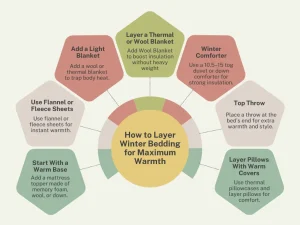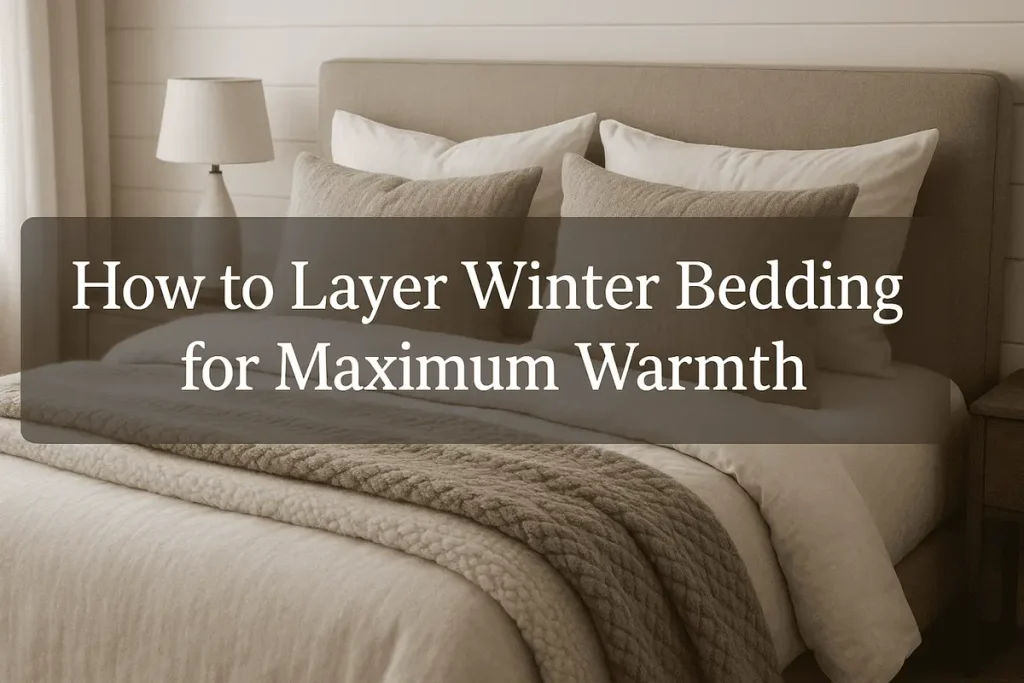Winter bedding is the special type of bedding used to stay warm and comfortable during cold weather. The smartest way to keep a warm bed in winter is by layering winter bedding instead of using just one heavy blanket.
You can do it simply by using different bedding pieces like a mattress topper, warm sheets, a blanket, and a duvet. In this way, your bed traps more heat. It feels cozier. It also lets you control your comfort easily. In this guide, you’ll learn how to layer winter bedding the right way for maximum warmth.
Why Layering Bedding Works Better Than One Heavy Blanket
Layer beddings have many simple benefits. Let’s discuss how it benefits you and help you use least energy:
Traps Heat Efficiently
Layering bedding creates multiple thin layers of air between each fabric. These air pockets act like insulation. They trap and hold your body heat for longer. A single thick blanket often lets heat escape because of the absence of air that can serve as an insulator.
Helps Regulate Body Temperature
You can easily adjust your comfort level according to your need with layered bedding. If you are feeling warm, you can simply remove one or more layers of bedding to enjoy the warmth that you need. If you are feeling cold, you can simply add more bedding layers. This simple flexibility prevents overheating and sweating which people experience with one heavy blanket that cannot be adjusted.
Saves Energy and Heating Costs
If you have warm and cozy bedding, there is a least need for room heaters because your bedding already holds enough heat to keep you comfy without raising the thermostat. As a result, your energy consumption reduces and your bills go down.
Winter Bedding Layer Order
In winters, it’s not recommended to use a single heavy blanket to keep you warm because it can cause overheating or sweating. To optimally control the warmth and coziness of your bed you must use layered winter bedding. Let’s discuss the correct order of the different components of layered winter bedding to keep you warm.
1. Mattress Protector
A mattress protector is the first layer of your winter bedding. It keeps your mattress clean and dry and adds the barrier against cold air that might come up from the floor or bottom.
2. Mattress Topper
A mattress topper adds extra softness and insulation. For winter, choose a memory foam, wool, or down topper. If you use the mattress topper out of these types, they block colds and improve comfort. This layer stops heat from escaping through the mattress.
3. Fitted Sheet
It covers the mattress and the topper. For this purpose, it is better to use flannel or brushed cotton fitted sheets for best bedding. Flannel or brushed cotton simply make you feel warm the moment you lie down
4. Flat Sheet (Optional)
A flat sheet is an optional layer to add more comfort. It creates a soft layer between you and your blanket. This makes it easy to adjust your temperature. Just pull it up or down if you feel too warm or cold.
5. Blanket or Thermal Layer
This is the main heat-trapping layer. For this layer, you can use a wool blanket, quilt, fleece blanket, or thermal blanket. It helps hold your body heat and keeps you warm all night. This layer is very important in cold weather.
6. Duvet or Comforter
You layer your duvet or comforter above the blanket. Use the comforter with a higher tog rating (10.5 to 15 tog) for winter. This layer provides strong insulation and locks in warmth.
7. Top Throw or Quilt
The final top layer is a throw or quilt. This adds extra warmth when needed. It is also useful for daytime naps without disturbing the rest of your bedding.
Read more: Why and How to Winterize Windows?
How to Layer Winter Bedding for Maximum Warmth
Layering your winter bedding is not a science but a simple process in which you have to follow simple order. The each step adds extra layer of warmth, comfort, and heat without making your bed feel too heavy
Start With a Warm Foundation
The first step of layering is placing a mattress topper on your mattress. It is usually made of memory foam, wool, or down topper. Due to its foamy composition, topper traps the air which acts as insulation and creates a warm base. This warm base does not allow the cold to rise up while you sleep.
Add Soft and Warm Sheets
Now the second layer includes covering it with flannel or fleece fitted sheets. Flannel or fleece fabrics keep your bed cozy unlike regular cotton sheets that can feel cold.
Use an Insulating Middle Layer
Now add a blanket or quilt. This layer acts as the main heat-holding layer. This middle insulating layer may be a thermal blanket, wool blanket, or cotton quilt. This layer traps your body heat before it escapes. If your room is too cold, instead of adding one thick blanket, you can add two thin blankets to add extra insulation.
Choose the Right Duvet or Comforter
In the fourth layer, place a comforter on the top of the blanket layer. For winters, you have to choose the comforter with the tog rating between 10.5 to 15. The greater the tog rating, the warmer the duvet. Go for 15 tog or a down-filled comforter if you live in extremely cold areas.
Finish With a Cozy Top Throw or Bed Runner
Add a throw blanket or bed runner at the end of your bed. This is useful if your feet get cold easily. It also adds a stylish layer to your winter bedding. It keeps your bed looking neat and cozy.
Use Thermal Pillowcases and Layered Pillows
Use thermal pillowcases or flannel pillow covers to keep your pillows warm. Layer two pillows; one for support and one for comfort. You can also add a body pillow for extra warmth and snugness.

Winter Bedding for Different Sleepers
Everyone has different perception of heat and cold. Some people feel too much cold while others get sweaty even in the winter. So, layering must be done according to the needs of body to stay comfortable. Lets discuss how we can layer winter bedding for people with different temperature needs.
For Cold Sleepers
Cold sleepers are the people who feel extra cold; therefore, to stay comfy, they need extra warmth. For this purpose, they must layer their winter bedding accordingly. They can use a warm base made of wool or memory foam. For extra warmth, they can use flannel or fleece sheets instead of breathable cotton sheets.
To trap the air perfectly, they can use a thick duvet rating of 13.5 to 15. A soft throw at the foot side of the bed can keep their feet warm; otherwise, cold feet can disturb sleep.
In short, we can say that cold sleepers must follow all the layering steps explained in the above section to keep themselves warm and comfortable.
For Hot Sleepers or Sweaty Sleepers
Unlike cold sleepers, Hot or sweaty sleepers are people who don’t feel too cold and get sweaty in the middle of the night due to the warmth of bedding and body heat. Such people should avoid heavy bedding that traps heat. Instead, they should use light and breathable fabrics like cotton or bamboo.
They can use a duvet with a lower tog rating, like 10.5. Moreover, instead of fleece blankets, they can use cotton or a waffle blanket, as it allows the airflow and reduces sweating. Down alternative comforters are also a good option because they give warmth without overheating.
For Allergies or Sensitive Skin
People with allergies have hypersensitive skin, and they need clean bedding that does not trap dust and dirt particles. Cotton, bamboo and down alternatives are excellent hypoallergenic materials for winter bedding.
Moreover, hypersensitive people must use anti-allergy mattress protectors and pillow covers to prevent dust mites. For extra safety, they must wash their bedding weekly with warm water to remove any allergens that can trigger hypersensitive reactions or allergies.
For Couples With Different Preferences
Couples sharing the same bed might have different sleep temperatures; one might be a cold sleeper, and the other might be a hot sleeper. For such couples, winter bedding is really a challenge.
An excellent solution is to either use a separate blanket or a dual tog duvet. The dual tog duvet is a comforter in which each side has different warmth levels because of the use of material with a dual tog rating. Moreover, layered bedding can also help because each person can adjust their side according to needs.
Explore more about: How to Winterize Your Home: Energy-Saving Tips
FAQs About Winter Bedding
What is the best tog rating for winter bedding?
For winter, choose a duvet with a tog rating between 10.5 and 15. 10.5 tog is enough if your home is warm. Select 13.5 tog if your home is cold. 15 tog is best for very cold areas.
Do I need a flat sheet in winter?
A flat sheet is optional. Some people like it because it adds a small extra layer and keeps the duvet cleaner. But you can skip it.
Is fleece better than flannel?
Both are warm. But they feel different. Fleece is very soft and warmer but can make you sweat. Flannel is warm too but more breathable. So it feels more comfortable for most people.
How do I keep my feet warm in bed?
If you had cold feet, your sleep would be very disturbed. To prevent it, you can use thermal socks or hot water bottles. As explained above you can customize your bedding layers accordingly by adding a throw blanket at the end of your bed. Moreover, you can use a longer duvet or comforter that can cover your feet better.
What is the best winter bedding for cold houses?
If your home gets very cold, use flannel sheets and wool blankets. Use a 15 tog duvet or down comforter. Also add a mattress topper. This stops cold air from coming through the mattress. You can also add all the layers explained in detail above in the blog to keep your winter bedding more cozy and comfortable.


